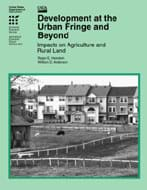Agricultural Economic Report No. (AER-803) 88 pp
Development at the Urban Fringe and Beyond: Impacts on Agriculture and Rural Land
Land development in the United States is following two routes: expansion of urban areas and large-lot development (greater than 1 acre per house) in rural areas. Urban expansion claimed more than 1 million acres per year between 1960 and 1990, yet is not seen as a threat to most farming, although it may reduce production of some high-value or specialty crops. The consequences of continued large-lot development may be less sanguine, since it consumes much more land per unit of housing than the typical suburb. Controlling growth and planning for it are the domains of State and local governments. The Federal Government may be able to help them in such areas as building capacity to plan and control growth, providing financial incentives for channeling growth in desirable directions, or coordinating local, regional, and State efforts.
Keywords: land development, sprawl, large-lot housing, land zoning, population growth, housing, specialty agriculture, high-value agriculture, rural amenities, smart growth
In this publication...


